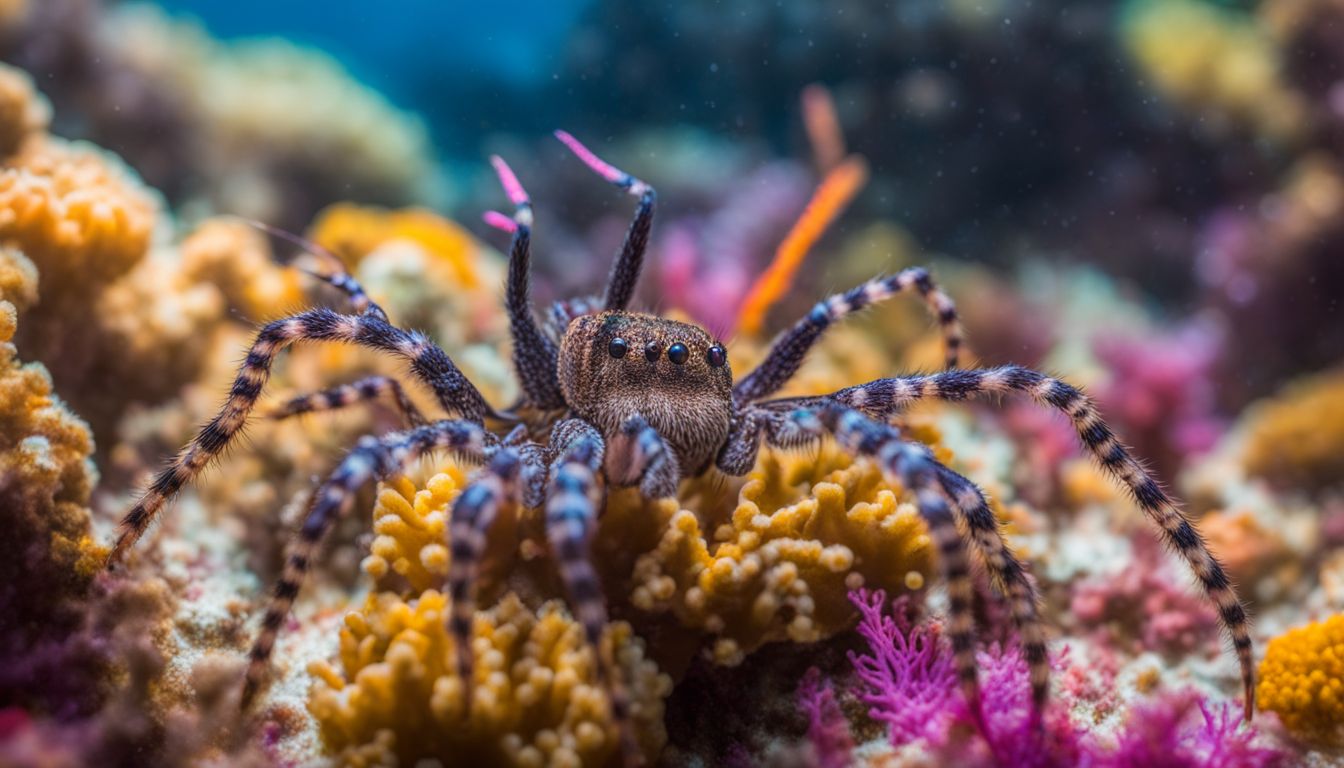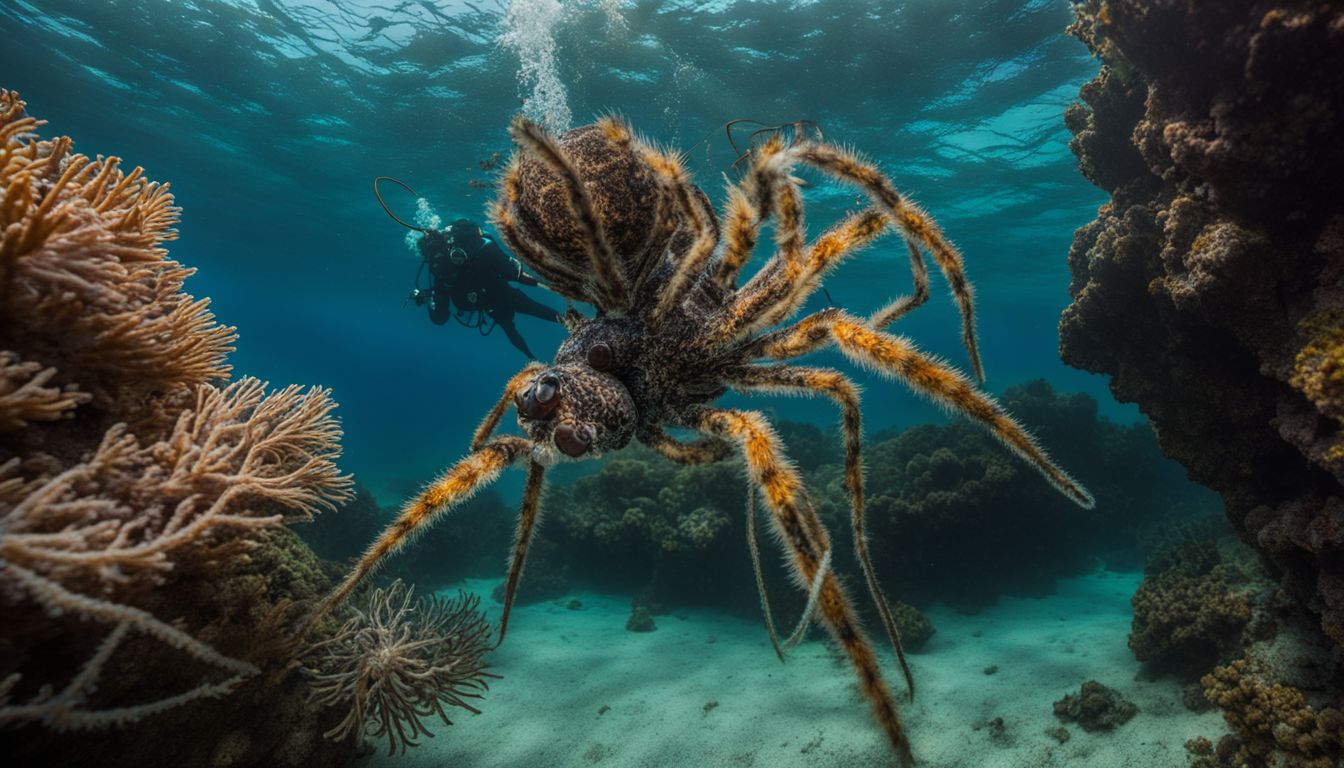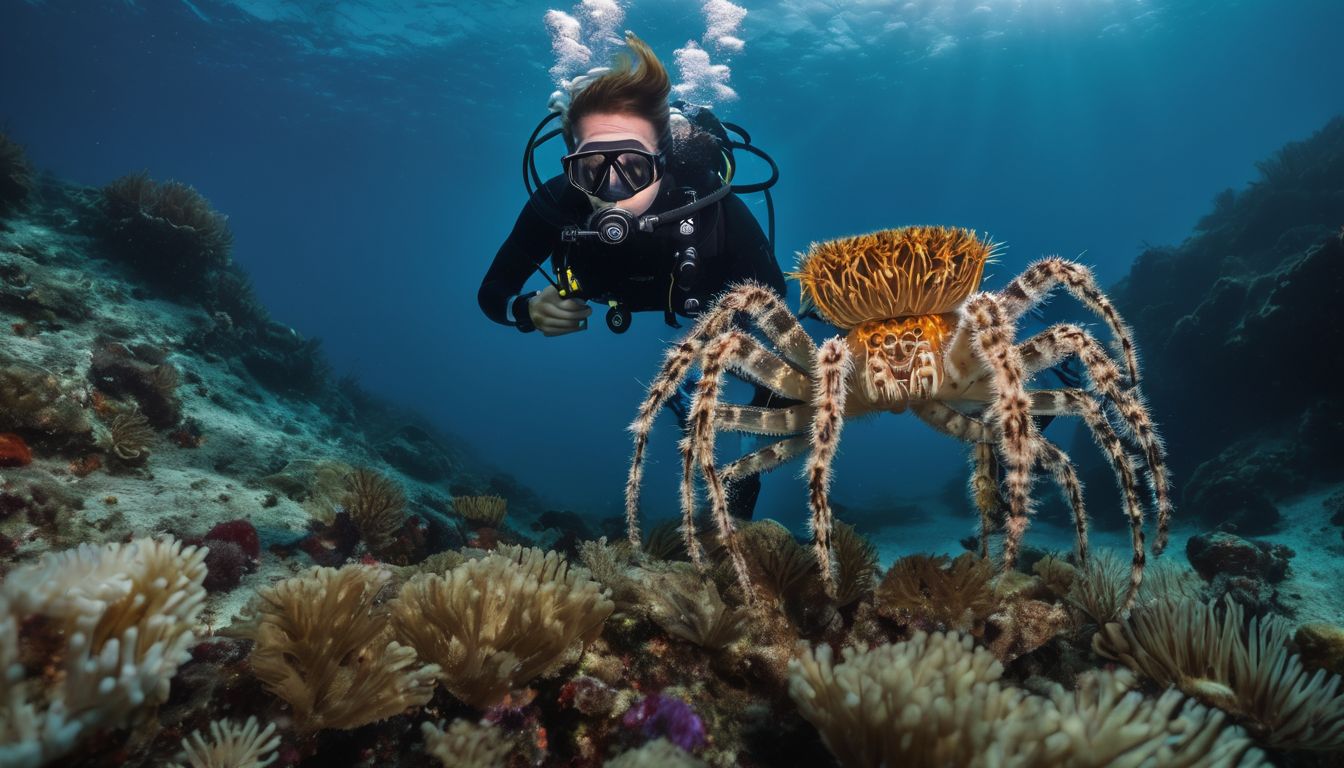Have you ever stumbled upon a photo of a sea spider and wondered if this creature could be harmful? Despite their alarming appearance, sea spiders are not poisonous to humans. Today’s blog will uncover the truth behind these marine critters, debunk myths about their danger, and introduce you to the fascinating world they inhabit.
Stay tuned for some surprising facts!
Key Takeaways
- Sea spiders are not dangerous to humans and do not pose a threat. Despite their unique appearance, they are generally harmless creatures.
- Sea spiders can inject venom, but it is primarily used for catching small sea animals and does not harm humans significantly. There is no evidence that sea spiders can bite or harm humans.
- These marine creatures have adapted to thrive in diverse underwater environments, from shallow waters to extreme depths of over 7,000 meters, showcasing remarkable resilience and survival capabilities.
- Sea spiders primarily feed on soft – bodied animals using their proboscis and can survive for long periods without food due to their slow metabolism.
Unveiling the Mystery: What Are Sea Spiders?

So, let’s dive deeper into who these sea spiders are. Sea spiders are not your typical garden variety of spider; they have a unique place in the marine world. These creatures fall under a group called pycnogonids and they look very different from the spiders we usually see around us.
Their bodies are small with long skinny legs that can sometimes be quite long compared to their body size. Imagine an animal that almost all leg! Sea spiders can have as many as eight legs, but some species may even sport up to 12.
Now imagine these odd-looking animals crawling around on the ocean floor or swimming through the water! With over 1,300 known species, sea spiders can be found in many marine environments – from tropical waters to icy depths of more than 7,000 meters deep where sunlight barely reaches.
They tiptoe across soft corals, sponges and hunt for small prey like nudibranchs and other tiny sea creatures. Despite their name and appearance, sea spiders don’t weave webs; they’re wandering hunters living life beneath the waves.
Debunking Myths: Are Sea Spiders Dangerous?

Many people fear sea spiders due to misconceptions about their danger, but in reality, they pose little threat to humans. Understanding the venom of sea spiders and debunking common myths about their bites can help put these fears to rest.
Understanding the Venom of Sea Spiders
Sea spiders can inject venom, just like some land spiders. This might sound scary, but their venom doesn’t hurt people much. Mostly, it helps them catch small sea animals to eat. Scientists are still learning about sea spider venom because we don’t see sea spider bites often.
If you did get bit by a sea spider, doctors aren’t sure if there’s an anti-venom yet. But don’t worry too much; these creatures live in the ocean and hardly meet people. Next up is another topic that often gets people mixed up: What really happens when a sea spider bites?.
Common Misconceptions About Sea Spider Bites
Many people think sea spiders are scary and can bite like land spiders. However, these marine creatures are not a threat to humans.
- People often believe sea spiders can bite them. This is not true. They don’t look to bite humans because they are focused on tiny prey in the ocean.
- Some folks are scared that sea spiders have venom like some land spiders do. But sea spiders are not poisonous to us at all.
- It’s easy to mix up sea spiders with beach wolf spiders or jumping spiders since they live near water too. Sea spiders live under the water, and they act very different from their land cousins.
- Another mistake is thinking a sea spider’s bite would hurt a lot. If one could bite, it wouldn’t be strong enough to harm human skin.
- Many get worried about getting sick from a sea spider’s bite. There’s no need for this worry because their bites don’t make people ill.
- Others have heard tales about huge sea spider bites. In truth, most of these creatures are small with thin legs that couldn’t do much damage even if they tried.
- Lastly, there’s a fear that if you get bit by one, you will need medicine or a doctor visit. Since they aren’t harmful, there’s no reason for medical care after meeting a sea spider.
The Anatomy of Sea Spiders
Sea spiders have a unique anatomy, with long legs and pycnogonid claws that help them navigate the ocean floor. They also possess extraordinary adaptations, such as the ability to regenerate lost limbs.
Unique Features: Legs and Pycnogonid Claws
Sea spiders have a unique body shape, with a small body and long legs. Their legs can be as long as 10 times their body size. These marine arthropods usually have eight walking legs, arranged in four pairs.
In addition to their unusual leg-to-body ratio, sea spiders also possess pycnogonid claws at the end of their legs, which they use for various tasks such as holding onto prey or surfaces in their aquatic environment.
Pantopoda’s bodies mostly consist of these long legs and a proboscis, leaving very little space for internal organs. They do not have respiratory systems like other animals; instead, they rely on diffusion for breathing through their exoskeletons.
Extraordinary Adaptations: Can Sea Spiders Regenerate?
Sea spiders have some extraordinary abilities, one of which is the power to regenerate. Young sea spiders can regrow their rear ends, and this ability might be connected to molting.
However, as sea spiders age and stop molting, they lose this regenerative capability. It’s pretty incredible that these marine organisms have the capacity to grow body parts back! The discovery of sea spiders’ regeneration skills raises interesting questions about potential uses in science and medicine.
The Habitat and Behavior of Sea Spiders
Sea spiders can be found in a variety of marine habitats, from shallow intertidal zones to the deepest oceans. Despite their name, they are not true spiders and have adapted to thrive in diverse ecosystems.
Their behavior includes predation on small animals such as sea anemones and other soft-bodied organisms.
Exploring the Depths: How Deep Can Sea Spiders Go?
Sea spiders can be found in various ocean depths, from shallow waters to more than 7,000 meters deep. They are known for their ability to thrive in extreme conditions, even in the freezing waters of Antarctica.
Despite their delicate appearance, sea spiders have adapted to survive across a wide range of underwater environments.
In the darkest and coldest parts of the ocean floor, sea spiders continue to flourish. Their unique physiology enables them to inhabit such profound depths where other marine creatures may struggle to survive due to extreme pressure and temperature.
Sea Spiders in Antarctica: Thriving in Extreme Conditions
Sea spiders in Antarctica thrive in a variety of ocean habitats, from shallow waters to the deep sea. They have adapted to extreme conditions by breathing through special holes in their legs, allowing them to survive and flourish in the frigid waters.
These unique creatures are particularly abundant in the polar regions, showcasing their remarkable ability to adapt to some of the harshest environments on Earth.
Thriving amidst extreme conditions, Antarctic sea spiders demonstrate extraordinary resilience by adapting and thriving in diverse ocean habitats. Their ability to breathe through leg holes allows them to flourish in cold waters, making these unique creatures particularly abundant in polar regions.
Sea Spiders’ Feeding Habits and Survival
Sea spiders are known for their unique feeding habits, as they primarily feed on soft-bodied animals like cnidarians and small crustaceans. They use a proboscis to suck out the body fluids of their prey, allowing them to survive in challenging environments.
How Long Can Sea Spiders Go Without Eating?
Sea spiders can go for long periods without eating because their metabolism is very slow. They have been seen surviving for several months without food. This ability helps them adapt to the challenging deep-sea environment where they live.
Sea spiders are fascinating creatures, and their feeding habits are just one of the many extraordinary aspects of their survival in the depths of the ocean. Let’s now delve into some frequently asked questions about sea spiders.
Frequently Asked Questions About Sea Spiders
– Do Sea Spiders Pose a Threat to Humans?
– What Preys on Sea Spiders?
Do Sea Spiders Pose a Threat to Humans?
Sea spiders do not pose a threat to humans. They are not poisonous and there is no evidence that they can harm or bite humans. It’s important to understand that sea spiders are generally harmless creatures.
Understanding this, let’s delve into the fascinating anatomy of sea spiders in more detail. Now, let’s explore their unique features: Legs and Pycnogonid Claws.
What Preys on Sea Spiders?
Sea spiders are not fierce predators. They mostly feed on organisms like hydroids and bryozoans. These are small, soft-bodied invertebrates found in the ocean. Sea spiders use their proboscis or straw-like mouthpart to suck the nutrients from their prey.
Pantopods, which are a type of sea creature, sometimes snack on sea spiders. However, they aren’t hunted by many other creatures due to their habitat and adaptability.
Conclusion
In conclusion, sea spiders are not dangerous to humans. Their appearance may be intimidating, but they pose no threat. Despite their unique features and behaviors, they do not harm people.
Understanding these creatures helps dispel myths about their danger.
To discover more about the incredible survival skills of these creatures, including how long sea spiders can survive without food, visit our in-depth article here.
FAQs
1. What are sea spiders?
Sea spiders, also known as Pycnogonida, are marine animals that look like spiders but are not true spiders. They live in the ocean and have long legs for walking on the seafloor.
2. Can sea spiders hurt people?
No, sea spiders are not dangerous to people. Their small size and weak mouthparts make them harmless to humans.
3. How do sea spiders catch their food?
Sea stars, crabs, and shrimp may find themselves prey to these creatures because they have unique ways of capturing food in the water.
4. Do all sea spiders look the same?
No, there’s a lot of variety among these absurd creatures! Some moult or shed their skin as they grow, while others can even regrow lost parts—how cool is that? And some are good at hiding since they’re camouflaged.
5. Are there any land-based relatives of sea spiders I might know about?
Yes! While different from typical centipedes or your garden spider, chelicerates include both land dwellers like arachnids (which can cause fear if you have arachnophobia) and water-dwellers like Argyroneta aquatica (the water spider), which creates underwater webs.




